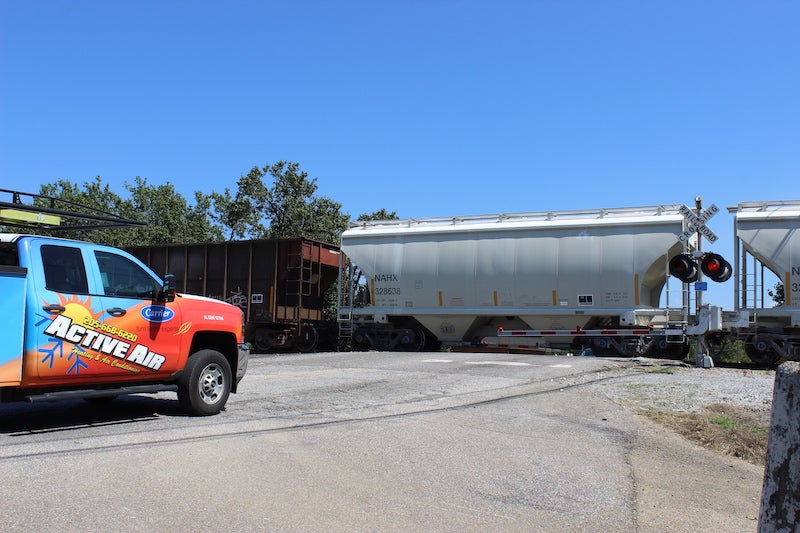Tracking an ongoing issue: A look on train blockages and their lasting impact on emergency response
Published 10:22 am Sunday, September 25, 2022

- When a train is stopped on the tracks at Calera's railroad crossing on Highway 25, which is a likely occurrence in Calera, emergency services are often hindered in getting to their intended destination. (Reporter photo/Meg Herndon)
|
Getting your Trinity Audio player ready...
|
By MEG HERNDON | Staff Writer
While attending to a civilian suffering from cardiac arrest, Helena’s Fire Captain Chaed Agee waited for an ambulance that would never get there.
As the ambulance attempted to cross Lee Street near Donut Joe’s, it found it could not get across the railroad crossing due to a stopped train, resulting in another ambulance having to be dispatched from another direction.
“We wound up being on the scene for a long time waiting,” Agee said.
Agee said those few short minutes are crucial in emergency situations, often determining life or death.
“It can really affect the outcome,” Agee said. “There are certain medical calls that are very time sensitive. Especially if it’s something like a cardiac arrest or a trauma patient where time’s very sensitive, it can definitely affect the outcome of a patient.”
While Helena and Pelham are not the only cities in Shelby County, or even the nation, to face an ongoing battle against train blockages, it has become a more prevalent topic in light of a recent fight for funding from the Railroad Crossing Elimination Grant Program for highway-rail or pathway-rail grade crossing improvement projects within the state, and the application deadline is just around the corner on Tuesday, Oct. 4.
Derailing response
Central Alabama Wellness, an outpatient treatment facility in Calera, sits near a train crossing in Calera.
“Their average occupancy every day is 50 people.” Calera Fire Chief Sean Kendrick said. “That includes patients and employees. We run multiple calls there per month and there was no access.”
Kendrick is referring to emergency access. When a train is stopped on the tracks at the crossing near Central Alabama Wellness, which is a likely occurrence in Calera, emergency services are often hindered in getting to their intended destination.
“Fortunately, in this event, further down the tracks, there was a road that would allow us access back to that area,” Kendrick said. “But it is a 5, almost 6-mile extension to our response time.”
Across cities, emergency responders know to brace for a potential increase of three to 12 minutes in response time due to a stopped train.
“I can’t say that it’s gotten better, I can’t say it has gotten worse,” Alabaster’s Fire Chief Tim Love said about the current status on blockages in the city. “We have good days and bad. We may go three or four weeks where we don’t have those long-term blockages, except at Fulton Springs, and then we may get two or three in a week.
“And it is a challenge,” Love continued. “We try to work our way around the tracks to get to different places. Of course, we’ve got stations on various sides of the track, but it still hampers our response to how to get around them.”
In addition to finding alternate routes or sending different responders from other stations, the firefighters also have to fight against heavier traffic created by the stopped train.
While some cities said they have not seen an increase or decrease in train traffic, Agee said the Helena Fire Department has experienced a rise in the Helena area. Agee also commented on the fact that it’s not just a matter of stopped trains that adds to their response time.
“Trains have gotten longer,” Agee said. “We see a lot of trains now that have what they call helper engines, where the train is long enough that somewhere in the middle they have another engine. So our time at the crossings, even for trains moving, is a lot longer these days.”
According to the U.S. Government Accountability Office (GAO), freight trains have been increasing in length, with some now coming in at nearly 3 miles long. While data on train length is not publicly available, GAO found that the average train length has increased by 25 percent since 2008.
The length can also cause trains to be stopped for longer when there are technical issues, which sometimes occur at a train crossing.
“We have issues sometimes where the trains will have a mechanical issue,” said the city of Pelham Communications Manager Ainsley Allison. “So then, you know, when that happens, they have to walk the full length of the train to try to figure out where issues are. They’re long trains, so, that can cause an example of a blockage that we’ve seen, five, six hours.”
During Memorial Day this year, Pelham saw a train blockage for more than 20 hours.
“It stopped at 10 o’clock on Sunday night, and then the train moved at 5 or 6 p.m., I believe,” Allison said.
Most of the blockages that Pelham sees do not last more than one or two hours, but sometimes Pelham does not see reports of those, which can impact emergency responders if they try to go a route that is not accessible.
“We’re only as good as the information that’s provided to us,” Allison said. “You’ll see people go on to Facebook and say, ‘Oh, there’s a train blocking, heads up. Don’t go that way.’ But those people don’t dial the dispatch non-emergency number and call and let our dispatch center know. So there may be a train sitting there for a long time. And we don’t know anything about it because nobody’s called us to tell us.”
Allison said Pelham encourages people to always call its dispatch number, 205-620-6550, to report if there is a blockage to let the city and EMS services know. She also noted that citizens can call CSX’s non-emergency number, 1-877-744-7279, to let the company know of the blockage.
Another issue that some Shelby County areas see is complete blockage of vehicle access to some areas when a train is stopped at a crossing.
According to Calera Police Chief David Hyche, some homes are completely inaccessible by vehicle when a train is stopped at certain sections of the railroad, blocking all access roads and affecting the way emergency services have to address an issue.
“So there is zero public safety that can be provided without crossing the tracks on foot,” Kendrick said. “We can’t transport patients out. We can’t access it. We can’t bring fire hoses and water to the fire.”
A brake in the dilemma
With trains growing in length and no current federal regulation on the amount of time a train is allowed to block a roadway, many cities do their best to mitigate the impact that the blockages have on civilians and emergency responders.
One way of doing this is seen in many cities’ automatic and mutual aid agreements.
“We’ve got a really good program,” Love said. “There’s the automatic aid program on the far side between us, Calera, Pelham and Helena. That’s just standard dispatch, all the time.”
When a dispatch call goes out about a structure fire, an automatic aid alert is sent to one of the other cities depending on location and mapping. Love said that Alabaster gets at least one additional engine company from one of the other three cities in agreement with Alabaster based on where the fire is located. This process is the same for other Shelby County cities.
In Pelham’s case, it is also in a partnership with Hoover for its northern city borders.
“So, if we’ve got an area blocked out by a train, and one of us can get to it, we make that call for each other,” Love said. “If an area is blocked and Pelham can get to Calera faster, (they’ll go).”
While the mutual aid agreement is helpful, it does not solve the problem entirely as it still hinders ambulances from getting to their intended destinations.
“You’ve also got the ambulances that are responding, trying to get there and working their way around,” Love said. “So, it’s pretty problematic for everybody.”
In a broader initiative, the Alabama Department of Transportation introduced a website to report blocked trains. If someone is near a crossing that is blocked by a stopped train, they can go to Fra.dot.gov/blockedcrossings where geo settings on their phone enable them to pinpoint the nearest railroad crossing and report the blockage.
“This is a challenge that our commuters and residents are altogether familiar with, a frustration that first responders can understand,” Shelby County Sheriff’s Office Maj. Clay Hammac said in a previous article about the introduction of the website. “We understand that there is a need for rail commerce and transportation.”
However, Agee said the website is so new that it is hard for some first responders to know if it has had any impact until more data has been collected over time.
In an even larger attempt to soothe the issue, the U.S. Department of Transportation announced in late June that more than $573 million would be available in grant funding for the 2022 fiscal year for the Railroad Crossing Elimination Program.
The funding was made available by the Bipartisan Infrastructure Law passed in 2021 which provides a total of $3 billion over five years in an attempt to “improve safety in communities, reduce wait times at railroad crossings, and help freight move goods more efficiently and affordably,” read a USDOT press release.
While $537 million is available nationally, only $114,652,800 can go to any one state. Therefore, many cities within Alabama, and even within Shelby County will likely be competing to receive grant money from the state.
One of those cities looking to receive funding is Pelham.
At a Pelham City Council meeting on Monday, Sept. 19, Resolution 2022-09-19-02 was approved for the city of Pelham to apply for funding from the program in an initiative to build an overpass over Highway 52 West.
“In the interest of public safety, we are making an application for that funding,” Allison said. “In a 24-hour period, we saw 32 trains come through both of those crossings. It added up to maybe two hours where those crossings were blocked for rail traffic. The longest one was during peak rush hour. (The crossing) was closed for 12 minutes.”
Allison said that if a firetruck needed to respond to that area it would take approximately one minute, but if there is a train there, it would add four minutes to the response time. Which, in the lifetime of a fire, can be devastating, especially now with modern houses which burn faster than older homes.
“You know houses now, flashover occurs much quicker,” Love said. “Three and four minutes added to any aspect can be a life and death situation from structure fires to medical calls.”
Calera is also looking into adding an overpass and seeking funding from the same grant program.
“We’ve been doing preliminary engineering,” Calera City Engineer Chris Pappas said. “We’ve met with ALDOT on that, and I got a favorable response from ALDOT to try to move that project forward. So, we’re applying for some federal funding in October.”
Pappas said that Calera has been working on an overpass project for several years, but it seems to have more traction now than it has in the past. The traction is likely because the state has limited funding, but with additional federal funding, it gives the state more resources financially to kickstart and finish a project, Pappas said.
The cost of an overpass project depends, but a preliminary estimate on Calera’s current projects is around $14 million. The FRA grant will provide an 80-20 match for projects, Pappas said. Meaning 80 percent of the funding will come from the federal government and 20 percent will come from local (city, county, state) funding.
If Calera gets approved for the grant, Pappas said it would be a couple of years before a project of that size would be ready to begin construction due to the added time of detailed engineering, environmental studies, permitting and the other intricacies that go into getting a project of that size off the ground.
Grant applications for the Railroad Crossing Elimination Program are due Tuesday, Oct. 4. Depending on the outcome, some Alabama cities could potentially see some form of an answer to a train problem that has affected communities for years.
Departing words
The only way to 100 percent combat the issue of train blockages would be to entirely get rid of all road and track intersections, which is not a reality that could be achieved in this lifetime if at all, many fire chiefs noted.
“The only real fix would be construction projects that give you viaducts or something that you can get over because trains are going to be there,” said Love. “And those are limited because of the economics. You’re looking at billions of dollars to be able to build something like that.”
Love also noted that if one overpass was built, such as over the Highway 119 crossing in Alabaster, he’d still have two other tracks that crossed it within three-quarters of a mile of each other in the city.
“So, you fix one, and then you’re still at the mercy of the other one,” Love said.
Love said that trains are not going anywhere as they’re the main methods of moving cargo across the country, which further impresses upon the importance of dialogue when it comes to first responders and railroad companies. He noted that working with the railroads and increasing awareness of where the trains are could help improve issues they face.
Other cities also hope to improve their dialogue with the railroad companies, as they see it as the best way to stay on top of any potential issues that might continue to arise due to blockages.
“We would just like for the railroads to have a dialogue with us about it,” Kendrick said. “We understand that they have their job to do, but we have our job to do as well. And a lot of these problems can be remedied by them stopping their trains a few miles further south where there are no crossings.”
At the end of the day, Kendrick said, Calera has a heart within railroads, which is why he thinks it’s important that the city and the railroads build and maintain a good partnership.
“Calera is a train city,” Kendrick said. “We have the Heart of Dixie Railroad Museum that attracts people from all over the country. And (Calera City Hall) is built to look like an old train depot. We have a railroad heritage here. We want to have a good relationship with the railroads because that’s what built the city.”









